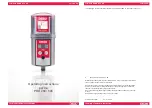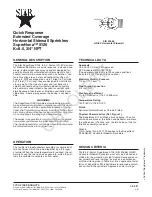
User Manual v1.9
Manual
WI-I/O 9-K
v1.9
Page 13
Each pulse input is counted as two 16 bit registers. The first register is the pulse count, and the
second register is the count of “overflows” of the first register - these two registers provide a 32
bit count of the pulse input. Each register can be transmitted individually. A “sensitivity” value
is configured for each pulse input (0 - 32 000). Whenever the pulse count has increased by this
value since the last transmission, the WI-I/O K will transmit the new pulse count. In addition, an
update transmission of the pulse count will be transmitted if the pulse count has not been
transmitted for the update time. If an update time of zero is selected, then no update messages
will be sent.
The maximum pulse input is:
300Hz for contact or NPN inputs (1 msec minimum on-time and off-time), or
10KHz (30
µ
sec minimum on-time and off-time) for TTL inputs. Up to 50KHz can be
achieved on PI2 provided the divider is set such that the scaled count rate is less than 10KHz
(see below).
There is no minimum pulse rate. For PI2, there is a configurable scaling divider (integer 1 –
255). This allows the pulse count to be scaled. If a divider of X is configured, then the pulse
count will increase by 1 for each X input pulses. There is a separate divider for each pulse input.
The divider parameter could be used for the following reasons:
If the pulse count is to be transmitted to a pulse output on a WI-I/O 9-x, then the maximum
pulse rate is 100Hz. If the input rate is more than 100Hz, then it can be reduced with the
divider. For example, if the maximum input rate is 300Hz, then the use of a 10 divider will
bring the effective rate down to 30Hz - each output pulse will then represent 10 input pulses.
The divider can be used to scale the pulse count to engineering units. For example, if the
input pulse rate is 7 pulses per m
3
of gas, then a divider of 7 will result in a pulse count
corresponding to the number of m
3.
Note that the divider must be an integer.
The divider could be used to slow down the pulse rate. If the input pulse rate is 5KHz, then
the base 16 bit counter will overflow in approx 13 seconds. If the overflow counter is not
used, then this may be too fast to be processed by HMI software. If a divider of 100 is used,
then the counter will take over 20 minutes to overflow.
There is no divider for PI1.
If the pulse count is transmitted to a pulse output on a WI-I/O 9-x module, the WI-I/O 9-x will
compare the input count to its own output count (the count of output pulses), and will then
output pulses until the two counts are the same. If the pulse counts are transmitted to a WI-I/O 9-
C or WI-I/O 9-G interface module, then the WI-I/O 9-C/G will store the pulse count value in an
internal register.
For pulse rates higher than 10 Hz, the “Fast Pulsed Inputs” option should be selected. This
increases power consumption of the module significantly and this needs to be considered if using
a battery power supply.














































